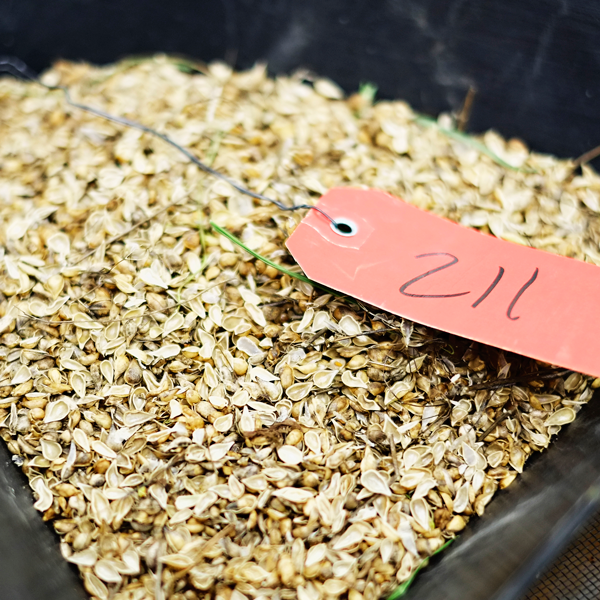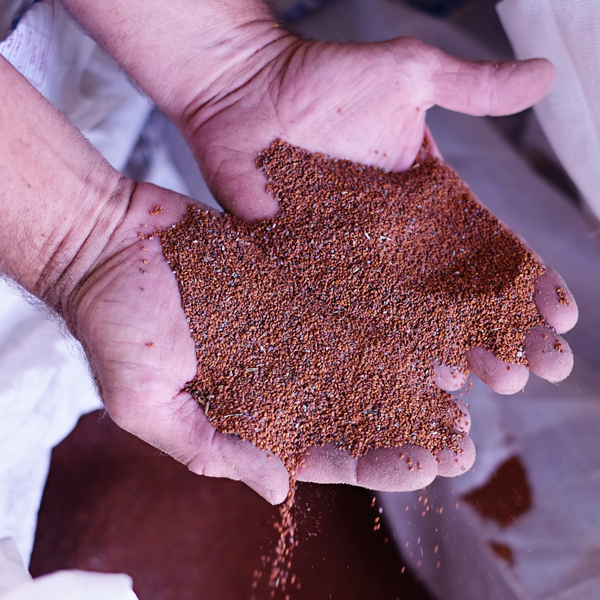Seed, Soil & Oil...
From ancient times until the early 1900s, camelina was commonly used to produce lamp and cooking oil, animal feed, and to supplement food grains. Dr. Steve Green, associate professor of Soil and Water Conservation, is reviving production of camelina, experimenting to determine which varieties are best adapted to Arkansas.
Green’s main research interests are in bioenergy cropping systems and soil sustainability. With funding from the U.S. Department of Energy, Green launched a bioenergy cropping systems farm where he is testing several types of plants with bioenergy potential, including 16 – 20 varieties of camelina. The research team is also exploring the effects of different inputs (i.e. chicken litter, municipal biosolids) on soil quality and the dynamics of plant nutrient use. Green explains the questions driving his research, “Can we take a waste product from another sector of society, use it as a resource, and get better or same yields as chemical fertilizer? Or in doing so, can we at least enhance the structure of the soil, reduce erosion and get environmental benefits that are useful to society? How will these modifications affect bioenergy crop yield and soil quality, and how can we best balance these needs?”
All plants grown on the bioenergy farm could potentially be used for biofuel production. When produced responsibly and developed as part of an integrated approach to sustainable, renewable, efficient energy, biofuels have important economic, environmental and national security potential. Biofuels can be sourced and consumed locally, creating jobs, boosting rural economies and reducing the need for fuel transport. In addition to decreasing carbon and greenhouse gas emissions, growth of winter crops for biofuel production can enhance soil health and sustainability, improving year-round crop yield and reducing pesticide and herbicide use. Incorporating biofuels into our transportation fuel supply will reduce our nation’s dependence on imported, non-renewable fossil fuels and help moderate fluctuating oil prices that are vulnerable to a myriad of global political crises and natural disasters.
Through interaction with local farmers, Green has learned “Arkansas farmers want to grow their own fuel so they can better predict their fuel costs. If they plant a winter bioenergy crop and locally refine it into biofuel, farmers can predict Through interaction with local farmers, Green has learned “Arkansas farmers want to grow their own fuel so they can better predict their fuel costs. If they plant a winter bioenergy crop and locally refine it into biofuel, farmers can predict
A priority, then, is finding bioenergy crops that can be grown reliably in Arkansas. Historically, camelina hasn’t been cultivated in North America, but biofuels research has led to a recent surge of interest in the plant. “As a cold-hardy winter crop,” Green explains, “I see possibilities for a soybean – camelina rotation. When rotating with winter wheat, soybean yield is often lower because by the time wheat is harvested, the soybeans get a late start. But camelina has a very short maturity cycle, which allows soybeans to be planted on time for optimal yield.” Of the plants grown on Green’s bioenergy cropping systems farm, camelina holds great promise for improving energy efficiency. And it could potentially serve as the energy source for its own production by replacing up to 100 percent of the fuel in existing diesel equipment. As such, this plant that powered ancient Greece and Rome may be a solution for our 21st century energy needs.
Camelina has broad commercial potential. The seed can be processed into oil and meal. The almond-flavored camelina oil contains an exceptionally high level of omega-3-fatty acids and is rich in vitamin E and natural antioxidants. To utilize the oil, Green says, “The easiest thing to do is make biodiesel fuel. It has been tested and can run farm tractors. The conversion process is feasible and cost-efficient ... and the oil can also be used to make camelina-derived jet fuel.” The U.S. Air Force and Navy have already tested 50/50 blends of camelina biofuel and jet propellent in flight demonstrations. Camelina meal, used as livestock feed, also has a high protein and omega-3-fatty acid content, which naturally enriches the resulting animal products. Animal waste may then be cycled back as a resource in camelina production.
Green and his colleagues are raising awareness of camelina and reaching out to Arkansas farmers through a capacity-building project funded by the U.S. Department of Agriculture. It features field days and demonstrations for farmers and other potential end users, with the expectation of establishing a camelina farmer network and oilseed cooperative. In addition to biodiesel, oil and meal production, Green sees other niche market opportunities for camelina, including extraction of specialty chemicals for use in cosmetics and hair care products. “But right now,” Green explains, “we’re not at the commercialization stage – now we’re trying to grow the right variety of camelina for Arkansas.”









